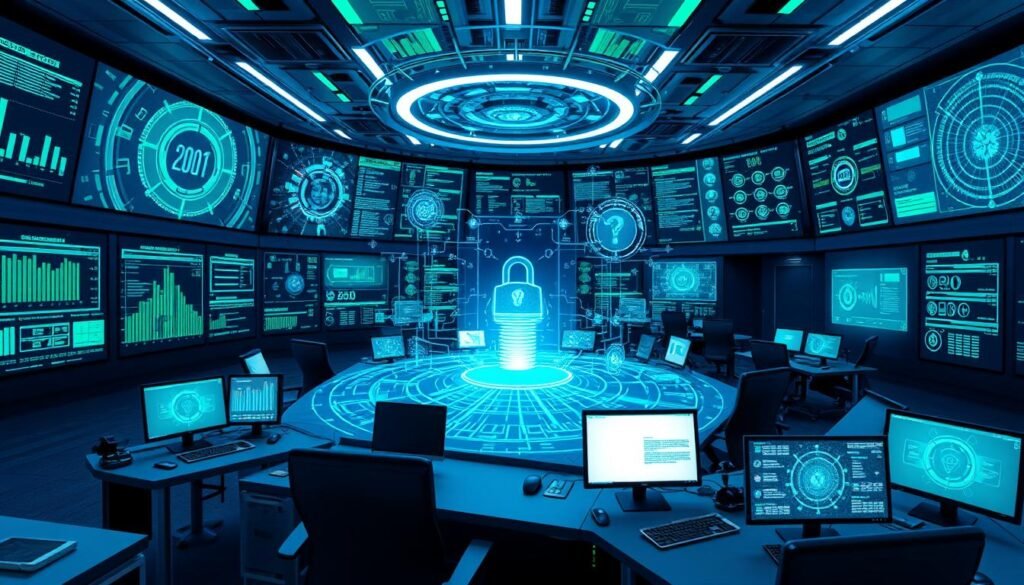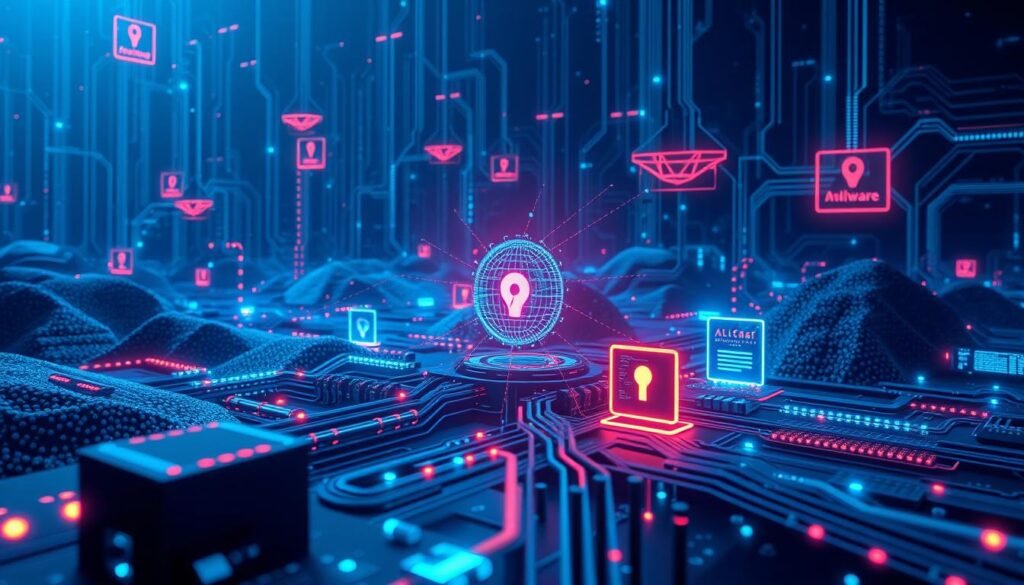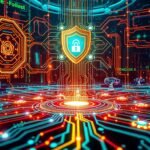Recently, 38% of cybersecurity experts have seen a big jump in cyber-attacks. This shows a huge increase in digital threats. The world of network security is changing fast, thanks to new tech and smarter cyber attacks.
Looking ahead to 2025, companies will face new network security challenges. They need to find new ways to protect themselves. This means using the latest strategies to keep up with the digital world.
More businesses will use secure browsers as work changes and cloud services grow. AI is also becoming key in network security. Companies are looking for ways to fight off advanced cyber threats.
Key Takeaways
- Secure browsers will become essential for business application access
- AI technologies are revolutionizing cybersecurity approaches
- Multi-vector attack prevention is critical for network protection
- Zero-trust architecture will replace traditional security models
- Post-quantum cryptography is emerging as a critical security strategy
Network Security Trends 2025, Advanced Cyber Threats, AI in Network Security
The world of cybersecurity is changing fast. Digital threats are getting smarter and more complex. It’s key for companies to keep up with these changes to protect their important systems.
Current State of Cybersecurity Landscape
Studies show how important cybersecurity is today. A survey of 1,700 IT pros found that 81% of companies use GenAI for better security. This shows how AI is playing a big role in keeping digital spaces safe.
- 81% of organizations use GenAI for cybersecurity
- 74% plan to develop 10+ AI-powered applications
- Significant rise in AI-driven security solutions
Evolution of Digital Threats
Cybercriminals are getting better at their tricks. In the second half of 2024, phishing attacks went up by 202%. Credential phishing attacks even jumped by 703%. This highlights the need for strong security measures.
“The future of cybersecurity is not about prevention, but intelligent response and adaptation.” – Cybersecurity Expert
Role of Artificial Intelligence in Protection
AI is changing how we fight cyber threats. Machine learning can spot security issues fast and accurately. AI and machine learning are set to be big in cybersecurity, helping to quickly find and stop new attacks.
| AI Security Metric | 2024 Performance |
|---|---|
| Phishing Message Detection | 202% Increase |
| Credential Phishing Prevention | 703% Improvement |
To keep up with cyber threats, your company needs to use AI for smart, flexible security. This will help protect against new digital dangers.
The Evolution of Secure Browser Technology
Digital workspaces are changing fast, making it key for companies to update their defense plans. With more people working from home, secure browsers are becoming a vital tool against new cyber threats.
Today’s businesses face big digital dangers that need new security ideas. The rise of BYOD security issues has made it important for companies to strengthen their defenses.
Browser-based Security Vulnerabilities
Cybercriminals often use web browsers to get into networks. They exploit:
- Unpatched browser software
- Malicious browser extensions
- Cross-site scripting attacks
- Phishing through browser interfaces
BYOD Security Challenges
Zero trust network architecture is key for managing different devices. Companies must tackle:
- Unauthorized device access
- Potential data leakage
- Inconsistent security protocols
- Varied user authentication methods
Data Leak Prevention Strategies
“Securing your digital perimeter is no longer optional—it’s a business imperative.” – Cybersecurity Expert
Protecting data needs a layered approach. This includes using advanced browser tech and strong security systems. Proactive monitoring and real-time threat detection are key to modern security.
By 2025, secure browsers will be key in keeping company data safe. 76% of security leaders will choose special cybersecurity tools to protect their digital spaces.
Government Infrastructure Protection and Smart Technologies
Governments are working hard to protect critical infrastructure from cyber threats. The world of national security is changing fast. New technologies need strong IoT security and smart cybersecurity AI plans.
The challenges are big. Recent studies show big weaknesses in government tech:
- 66% of transportation groups have faced ransomware attacks
- 77% of government groups don’t know all about their IoT devices
- Critical infrastructure is at risk from advanced cyber attacks
5G network security is key for government updates. Next-generation firewalls (NGFWs) help protect industrial sites and remote places from complex cyber threats.
“Securing smart technologies is no longer an option—it’s a national imperative.”
Investments are going into integrated security solutions. These protect old systems and new ones. Organizations are focusing on using AI for threat detection and strong infrastructure protection.
| Security Domain | Key Focus Areas | Implementation Strategy |
|---|---|---|
| IoT Security | Device Visibility | Comprehensive Monitoring Systems |
| 5G Network Protection | Threat Prevention | Advanced Firewall Technologies |
| Cybersecurity AI | Predictive Defense | Machine Learning Algorithms |
The future of government infrastructure security is in smart, adaptable systems. These can spot and stop threats before they happen.
Post-Quantum Cryptography in Modern Security
The world of network security is changing fast with post-quantum cryptography (PQC). As quantum computers get better, old encryption methods are at risk. They could face attacks from quantum computers.
Quantum cryptography is a strong defense against cyber threats. It helps businesses stay safe in a digital world that’s getting more complex. Moving to quantum-resistant algorithms is key for any modern company.
Understanding PQC Attacks
Quantum computers are a big threat to current encryption. They could:
- Crack current encryption algorithms
- Damage data integrity
- Find weaknesses in systems
Impact on Enterprise Security
Companies are getting ready for a future with quantum-safe security. They need to:
- Use quantum-resistant encryption
- Be flexible with their crypto
- Keep their data safe
| Sector | PQC Adoption Readiness | Implementation Timeline |
|---|---|---|
| Defense | High | 2024-2025 |
| Finance | High | 2025-2026 |
| Healthcare | Medium | 2026-2027 |
Implementation Strategies
To stay ahead in quantum security, your company can:
- Check your crypto systems
- Invest in quantum-safe tech
- Train your team on new tech
“The future of cybersecurity is quantum-resistant, and preparation starts now.” – Cybersecurity Innovation Council
By using post-quantum cryptography, your company will lead in network security. You’ll be ready to face new cyber threats.
Multi-Vector Attack Prevention Strategies
Cybersecurity is facing a big challenge. Old ways of defending against attacks are not working anymore. Ransomware has changed how hackers get into networks, making it hard to stop them.
Using machine learning to fight cyber threats is now key. Cybercriminals use many ways to get into systems at the same time.
“By 2025, attackers are predicted to have an 80% success rate in executing undetected attacks through next-generation AI tools.”
Key Prevention Strategies
- Implement advanced DNS attack prevention techniques
- Deploy AI-powered threat detection systems
- Develop integrated security platforms
- Utilize proactive threat hunting methodologies
Here are some important facts about fighting multi-vector attacks:
| Attack Vector | Prevalence |
|---|---|
| Malware-Free Attacks | 75% |
| Cloud Intrusions | 75% Increase |
| AI-Generated Threat Messages | 40% |
Your company needs to move from just reacting to threats to being proactive. Using AI to defend against cyber attacks is vital for keeping your systems safe in 2025 and later.
AI-Powered Security Operations and Skills Gap
The world of cybersecurity is changing fast thanks to artificial intelligence. AI is becoming key in fighting digital threats. It helps solve the problem of not enough skilled workers in cybersecurity.

The current cybersecurity team is facing big challenges. There are about 663,434 job openings in the U.S. But, only 1.1 million people are working in this field. This shortage makes it hard for companies to keep their systems safe.
Copilot Integration in Security
AI-powered copilots are changing how we do security work. They help by giving smart help. This includes:
- Instant threat detection insights
- Automated task management
- Enhanced operational efficiency
“By 2025, organizations will deploy AI systems that seamlessly integrate with existing security infrastructure, bridging critical talent gaps.”
Automation of Security Tasks
AI is changing how cybersecurity experts do their jobs. Now, they can automate boring tasks. This lets them focus on stopping threats in a smarter way.
Workforce Development
We need to find ways to close the skills gap. 85 percent of CEOs think AI skills will get better in the next three years. Companies need to invest in training and new tech to stay ahead.
| Workforce Challenge | Current Status |
|---|---|
| Global Cybersecurity Positions | 3.4 million unfilled roles |
| Confidence in Cybersecurity Talent | Less than 25% across critical sectors |
As AI gets better, cybersecurity workers need to keep learning. They must get used to new tech and learn skills that work well with AI.
Secure Access Service Edge (SASE) Implementation
As we look towards 2025, the Secure Access Service Edge (SASE) is changing how companies handle network security. Zero-trust security models are key for businesses in today’s digital world. By 2025, the SASE market is expected to hit a huge USD 10 billion, showing a big change in cloud security plans.
“SASE represents the future of integrated network and security infrastructure for distributed workforces.”
What’s driving SASE adoption includes:
- Rapid growth of remote work
- More use of cloud services
- Combining networking and security
- Better threat detection
Companies are focusing on SASE for its all-in-one network security solution. Market research shows interesting facts:
| Market Aspect | 2025 Projection |
|---|---|
| Business SASE Adoption | 60% with clear plans |
| Security Priority | 48% on security integration |
| Expected Market Growth | 25% CAGR from 2024-2032 |
Your company can use SASE for a safer, more flexible, and efficient network. By adopting these advanced cloud security tools, you’ll keep your data safe and your team productive.
Artificial Intelligence Security Challenges
The fast growth of AI technologies brings new security challenges. These need fresh ways to protect data and networks. As more AI is used, it’s key to grasp the complex AI security world.

AI is changing how we fight cyber threats. The growing complexity of AI security needs a wide strategy to tackle new risks.
Large Language Model Security Concerns
Large Language Models (LLMs) pose unique security risks. These AI systems can leak sensitive info in several ways:
- Unintended data leakage during model training
- Potential exploitation of model vulnerabilities
- Risk of generating malicious content
Data Protection Strategies in AI Systems
Strong data protection is vital for AI systems’ integrity. Important strategies include:
- Implementing strict access controls
- Encrypting sensitive training data
- Conducting regular security audits
| AI Security Challenge | Potential Impact | Mitigation Strategy |
|---|---|---|
| Model Vulnerability | Data Exposure | Advanced Encryption |
| Training Data Risk | Unauthorized Access | Strict Access Controls |
| Generative AI Threats | Malicious Content Generation | Content Filtering Algorithms |
Compliance Requirements for AI Security
Organizations must navigate complex regulations with clear compliance frameworks. Proactive risk management and clear AI governance are key. They help protect data and keep stakeholders’ trust.
“As AI technologies evolve, security must be a core consideration, not an afterthought.” – Cybersecurity Expert
Unified Security Operations Center Evolution
The world of cybersecurity is changing fast, with Security Operations Centers (SOCs) leading the way. Today, SOC teams are changing how they handle threats, thanks to AI. This new technology is making a big difference.
“The future of security is not about detecting threats, but preventing and automatically remediating them in real-time.” – Cybersecurity Expert
Managing security alerts is getting harder for companies. Analysts deal with about 5,000 alerts every day. This makes it tough to spot threats. But, AI is making it easier and more accurate.
- AI automation reduces manual threat hunting efforts
- Automatic remediation becomes a primary SOC capability
- Real-time threat detection improves organizational resilience
Here are some important numbers:
- 70% of SOC analysts now focus on proactive threat hunting
- Initial compromise to data exfiltration can occur within hours
- Annual cybercrime costs reached $9.2 trillion in 2024
Looking ahead to 2025, the unified Security Operations Center will keep getting better. It will use AI and automation to make networks safer and more intelligent.
Cloud Security Platform Integration
The cloud world is changing fast, with 60% of company data stored in the cloud. As businesses move online, keeping data safe is more important than ever. This is key for protecting sensitive info and keeping operations running smoothly.
DevSecOps is changing how companies handle network security in 2025. Cloud security platforms help solve big problems for today’s businesses:
- They give a clear view of cloud and on-premises data
- They find and fix threats quickly
- They bring security efforts together
Cybersecurity experts say we need better protection fast. 87% of companies now focus on zero-trust security. This means checking who gets access with many checks.
“Cloud security is no longer an option—it’s a necessity for business survival in the digital age.”
When choosing a cloud security platform, consider these:
- Fixing 99% of possible misconfigurations
- Strong identity management
- AI for finding threats
The future of cloud security needs a proactive, all-in approach. It must use the latest tech and smart risk management. With the right cloud security platforms, you can turn weak spots into strong defenses.
Conclusion
As we look at network security trends for 2025, it’s clear that we need a new way to fight cyber threats. AI in network security is now a must, not just a nice-to-have. Companies must use the latest tech to protect themselves from advanced threats.
The future of network protection relies on smart systems that can stop threats early. New tech like AI and machine learning are making cybersecurity better. Both small and big businesses need to invest in strong threat detection to keep their data safe.
Your cybersecurity plan must tackle new threats like AI-powered phishing and deepfake scams. The 2025 threat scene demands a complete approach with AI, strong security, and training. By using these new tools, you can defend against the toughest cyber attacks.
Success in network security means being quick to adapt and innovate. Using AI, quantum computing, and smart threat detection is key. This new approach turns weaknesses into strengths, helping you stay ahead of cyber threats.



